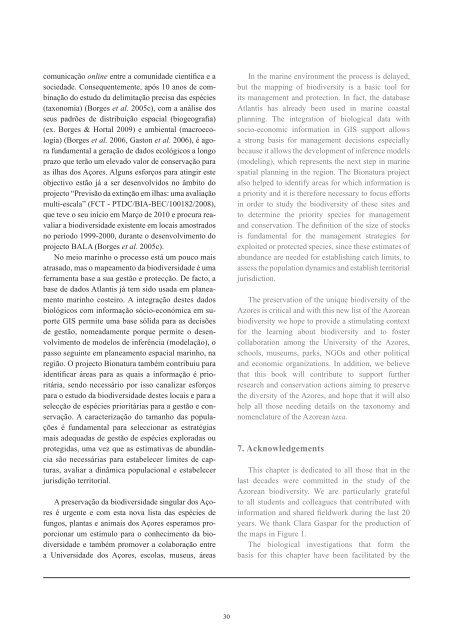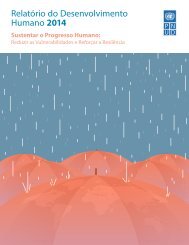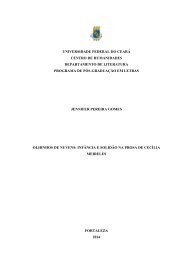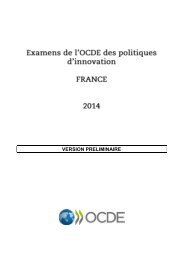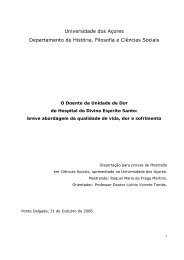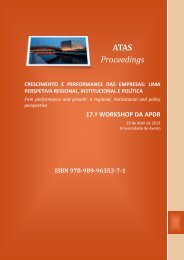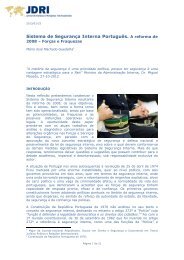1POTXAdSn
1POTXAdSn
1POTXAdSn
Create successful ePaper yourself
Turn your PDF publications into a flip-book with our unique Google optimized e-Paper software.
comunicação online entre a comunidade científica e a<br />
sociedade. Consequentemente, após 10 anos de combinação<br />
do estudo da delimitação precisa das espécies<br />
(taxonomia) (Borges et al. 2005c), com a análise dos<br />
seus padrões de distribuição espacial (biogeografia)<br />
(ex. Borges & Hortal 2009) e ambiental (macroecologia)<br />
(Borges et al. 2006, Gaston et al. 2006), é agora<br />
fundamental a geração de dados ecológicos a longo<br />
prazo que terão um elevado valor de conservação para<br />
as ilhas dos Açores. Alguns esforços para atingir este<br />
objectivo estão já a ser desenvolvidos no âmbito do<br />
projecto “Previsão da extinção em ilhas: uma avaliação<br />
multi-escala” (FCT - PTDC/BIA-BEC/100182/2008),<br />
que teve o seu início em Março de 2010 e procura reavaliar<br />
a biodiversidade existente em locais amostrados<br />
no período 1999-2000, durante o desenvolvimento do<br />
projecto BALA (Borges et al. 2005c).<br />
No meio marinho o processo está um pouco mais<br />
atrasado, mas o mapeamento da biodiversidade é uma<br />
ferramenta base a sua gestão e protecção. De facto, a<br />
base de dados Atlantis já tem sido usada em planeamento<br />
marinho costeiro. A integração destes dados<br />
biológicos com informação sócio-económica em suporte<br />
GIS permite uma base sólida para as decisões<br />
de gestão, nomeadamente porque permite o desenvolvimento<br />
de modelos de inferência (modelação), o<br />
passo seguinte em planeamento espacial marinho, na<br />
região. O projecto Bionatura também contribuiu para<br />
identificar áreas para as quais a informação é prioritária,<br />
sendo necessário por isso canalizar esforços<br />
para o estudo da biodiversidade destes locais e para a<br />
selecção de espécies prioritárias para a gestão e conservação.<br />
A caracterização do tamanho das populações<br />
é fundamental para seleccionar as estratégias<br />
mais adequadas de gestão de espécies exploradas ou<br />
protegidas, uma vez que as estimativas de abundância<br />
são necessárias para estabelecer limites de capturas,<br />
avaliar a dinâmica populacional e estabelecer<br />
jurisdição territorial.<br />
A preservação da biodiversidade singular dos Açores<br />
é urgente e com esta nova lista das espécies de<br />
fungos, plantas e animais dos Açores esperamos proporcionar<br />
um estímulo para o conhecimento da biodiversidade<br />
e também promover a colaboração entre<br />
a Universidade dos Açores, escolas, museus, áreas<br />
30<br />
In the marine environment the process is delayed,<br />
but the mapping of biodiversity is a basic tool for<br />
its management and protection. In fact, the database<br />
Atlantis has already been used in marine coastal<br />
planning. The integration of biological data with<br />
socio-economic information in GIS support allows<br />
a strong basis for management decisions especially<br />
because it allows the development of inference models<br />
(modeling), which represents the next step in marine<br />
spatial planning in the region. The Bionatura project<br />
also helped to identify areas for which information is<br />
a priority and it is therefore necessary to focus efforts<br />
in order to study the biodiversity of these sites and<br />
to determine the priority species for management<br />
and conservation. The definition of the size of stocks<br />
is fundamental for the management strategies for<br />
exploited or protected species, since these estimates of<br />
abundance are needed for establishing catch limits, to<br />
assess the population dynamics and establish territorial<br />
jurisdiction.<br />
The preservation of the unique biodiversity of the<br />
Azores is critical and with this new list of the Azorean<br />
biodiversity we hope to provide a stimulating context<br />
for the learning about biodiversity and to foster<br />
collaboration among the University of the Azores,<br />
schools, museums, parks, NGOs and other political<br />
and economic organizations. In addition, we believe<br />
that this book will contribute to support further<br />
research and conservation actions aiming to preserve<br />
the diversity of the Azores, and hope that it will also<br />
help all those needing details on the taxonomy and<br />
nomenclature of the Azorean taxa.<br />
7. acknowledgements<br />
This chapter is dedicated to all those that in the<br />
last decades were committed in the study of the<br />
Azorean biodiversity. We are particularly grateful<br />
to all students and colleagues that contributed with<br />
information and shared fieldwork during the last 20<br />
years. We thank Clara Gaspar for the production of<br />
the maps in Figure 1.<br />
The biological investigations that form the<br />
basis for this chapter have been facilitated by the


